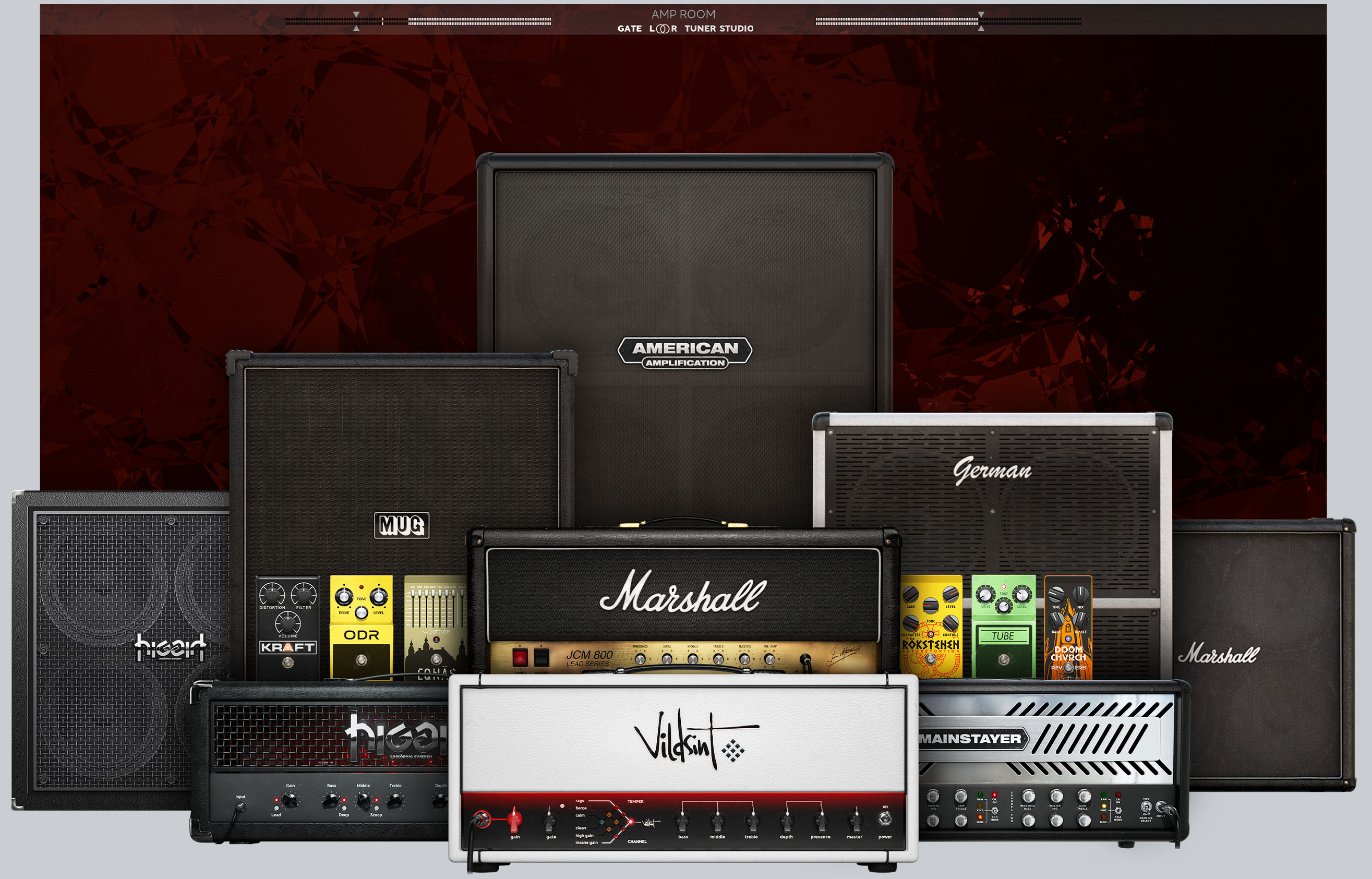

User Manual
Getting started (quick start-manual)
Suite Gear
Amplifiers
Cabinets
IR loader LoadIR module
Pedals and Studio Effects
Credits
Getting started (quick start-manual)
Presets
Amp Room factory presets are your friend for both quickly learning how Amp Room works and for finding great sounds fast. You can find factory and User presets both here:
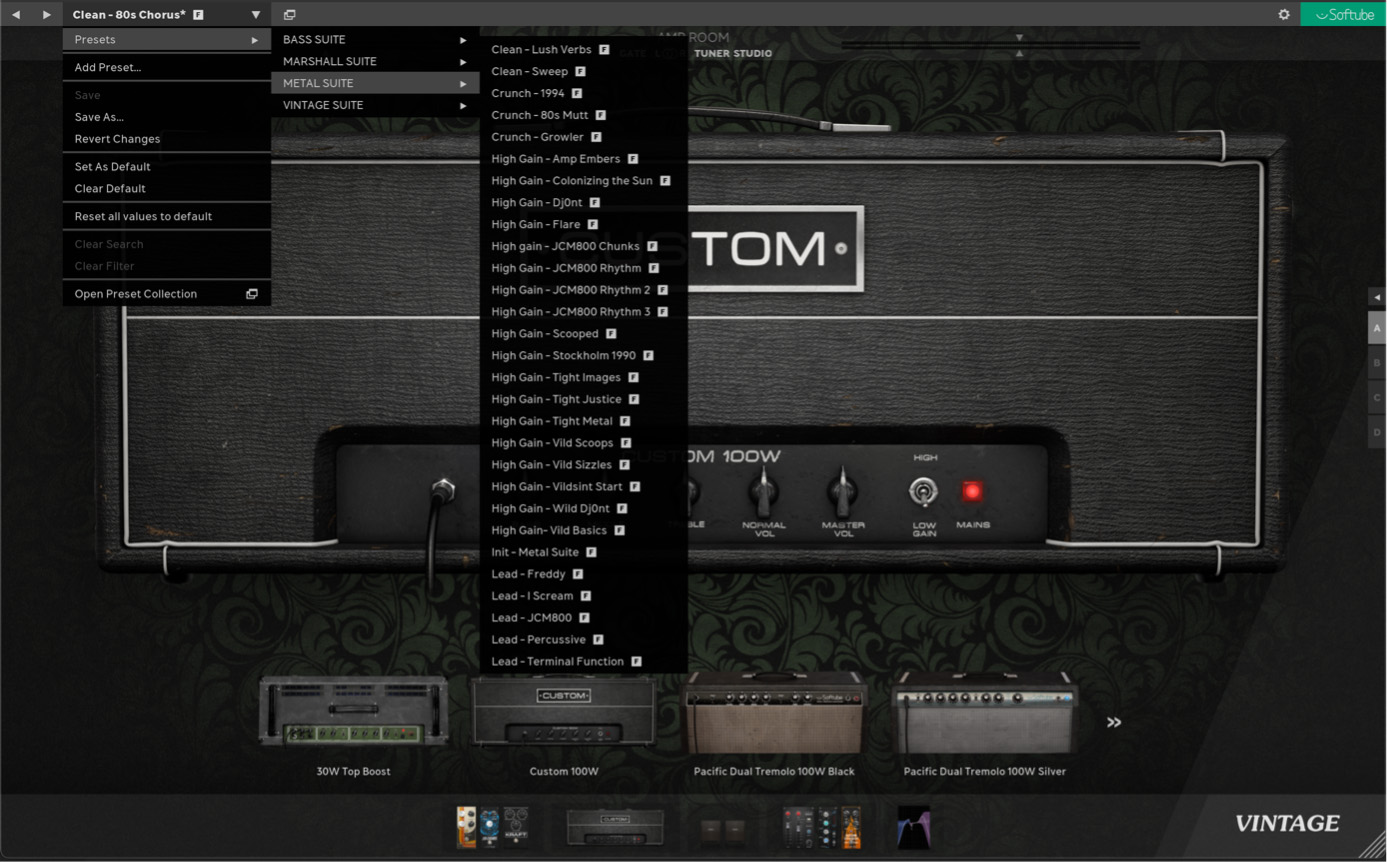
And here. This will open Preset Collection in a pop-up window. See the Preset Collection manual for more information.
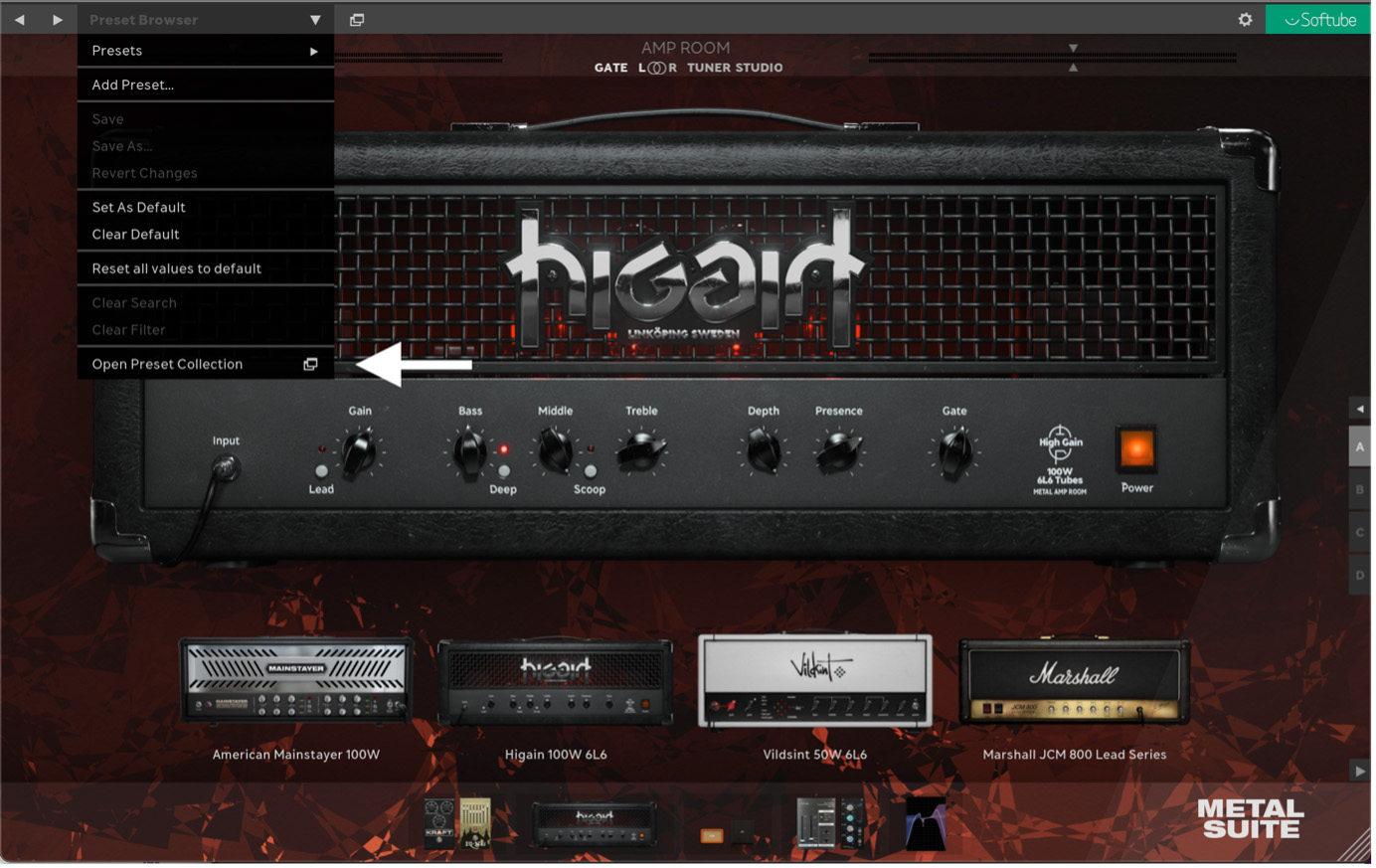
Switching between Suites
If you own more than one Amp Room Suite, you can switch between Suites by clicking on the Suite selector and selecting another Suite in the list. Choosing a preset from another Suite will automatically switch Amp Room to the Suite where the preset belongs.
The currently loaded Suite (see arrow) is activated on mouse-over. To deactivate this mouse-over pop-up, see “Settings” (cog wheel, top right corner).

Note: all current signal chain progress will be lost when switching to another Suite/preset.
When loading a Suite, only the content that comes with it will show in the amp and cab section. If you own multiple suites, you can always access content from other suites by clicking the "Show all" button in the amp and cab section. Click again to hide non-suite specific content. The pedal and effects sections always show everything.
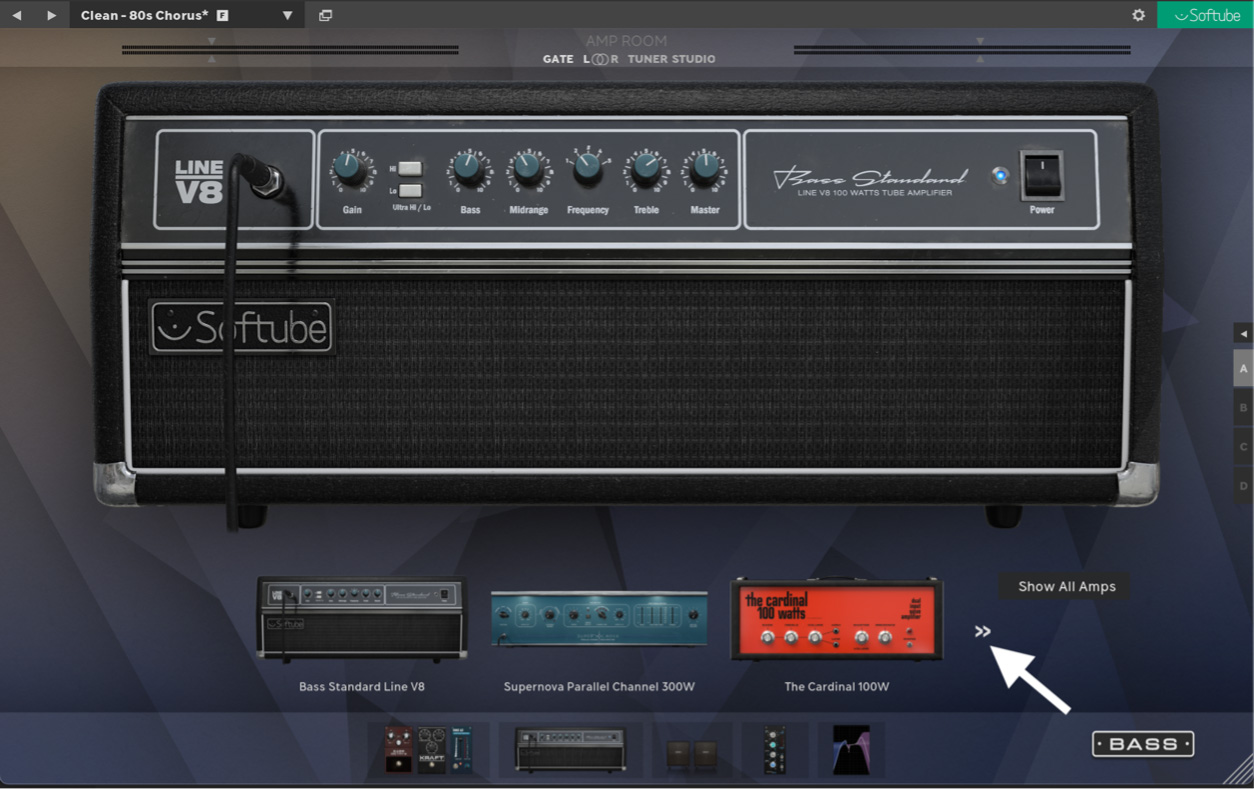
This concludes the Suite Quick Start manual over Amp Room. We strongly recommend that you also check out the main Amp Room manual for information on Studio mode and all the over features and functions of Amp Room.
Note: Apart from the gear that is included in the Suite, all Amp Room Ready Softube products that you own will also be accessible automatically inside Amp Room. For a complete list of Amp Room Ready plugins, please see the Amp Room Ecosystem page.
Vildsint 50W 6L6
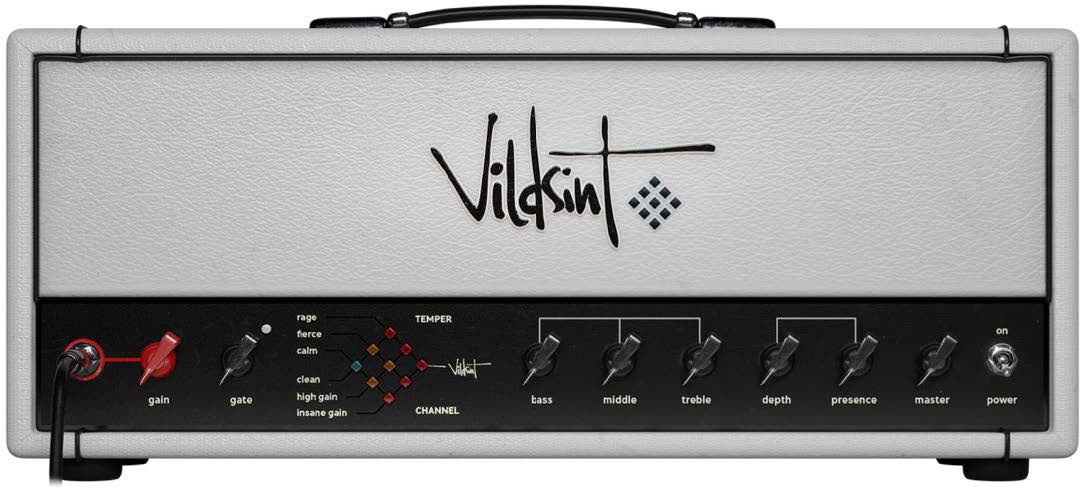
If you’re looking for a wild, yet versatile modern high gain guitar amp, look no further! Vildsint 50W 6L6 is an utter beast with its three channels and two built-in boosts that will propel your riffs into modern metal heaven. Tight lows, perfect for downtuned and extended range guitars, but with a percussive punch and clarity unique to this tube-fueled predator.
Higain 100W 6L6
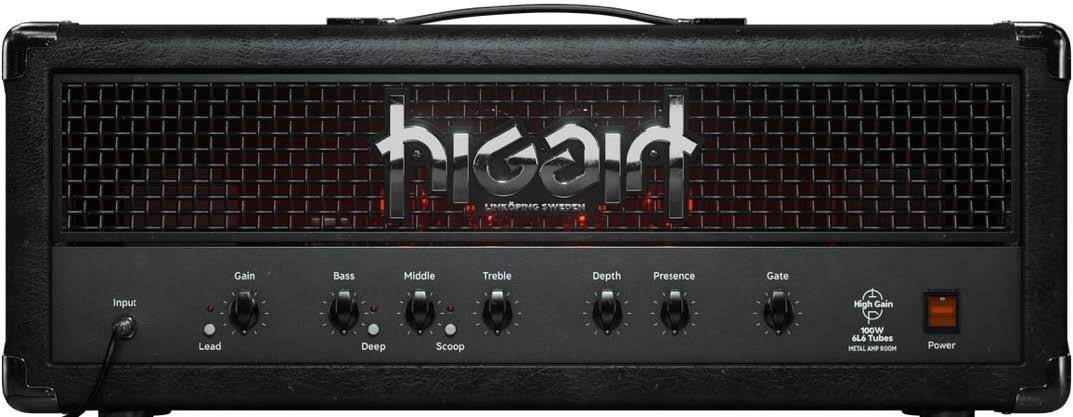
This German high-gain 100W amp packs a lot of mid-frequency punch along with smooth- to-aggressive distortion. Its unforgiving nature (due to its ability to articulate even the most heavily distorted tones) is its key feature. Thrashier riffs will also feel at home on this amp as palm-muting also being one of its fortes.
American Mainstayer 100W
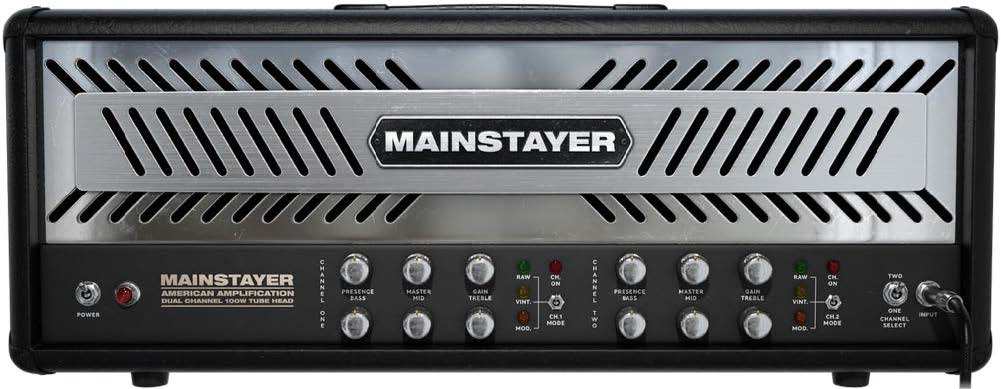
This amp probably needs no introduction. It is an absolute “mainstay” in the scene since its origin in the early 90’s. Few amps have had such tremendous impact on distorted and high gain music as this amp has had. The American Mainstayer 100W features two channels. Channel one is perfect for that crunchier hard rock tone and has heavy, low frequencies in spades, whereas channel two is tweaked more towards the demands of high gain metal.
A tip is to use the Softube Tube or Softube ODR pedal in front of the amp while playing channel one, perhaps along with a High Shelf filter utility tool to control the sometimes overly loose low frequencies. In general, channel one often needs some tonal sculpting, but is the perfect channel for creating your own desired tone.
Another thing to keep in mind is that a lot of great tone results are achievable by combined tweaking of the Presence, Master Volume and Gain knobs alone. The amp takes some time to get to know, but you are almost certain to find tones that you like with this amp.
Marshall JCM800 Lead Series
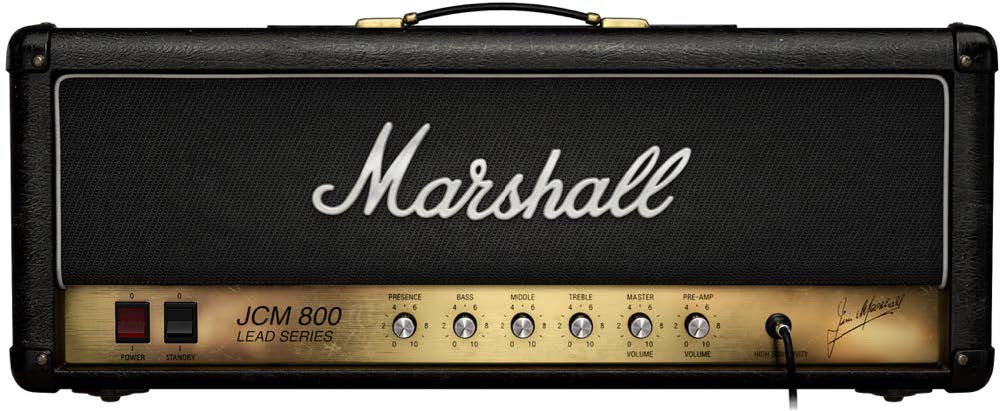
Nothing embodies the essence of the Marshall tone more than the classic JCM800. Introduced in 1981. It was the second Marshall amp that featured a master volume control, which allows you to further sculpt the tone. With preamp on full and a low master volume, you’ll get a tight overdriven sound, while the opposite setting gives you a looser and more vintage sounding distortion.
The JCM in the name stands for James Charles Marshall, and the seemingly meaningless number 800 was taken from his license plate. Later, it was said to represent the decade (the 1980’s).
The tone stack Bass, Middle, Treble, and Presence controls will behave quite differently depending on your Master Volume setting, and the Pre-Amp volume will also change tonality depending on its setting. While the amp seems simple at first glance, there’s more to it than meets the eye.
American Mainstayer 4x12
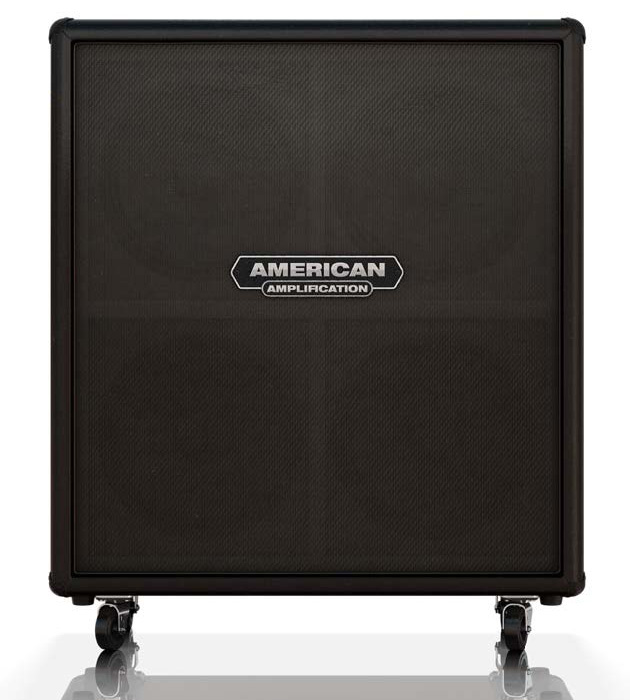
The American Oversized 4x12" is the "Oversized cab to rule them all". Built to accommodate the thunderous range of the American high-gain Mainstayer-amp series, it is now the go-to cabinet for firm high-gain low frequency response.
Speaker: Celestion Vintage 30
German Viper 4x12
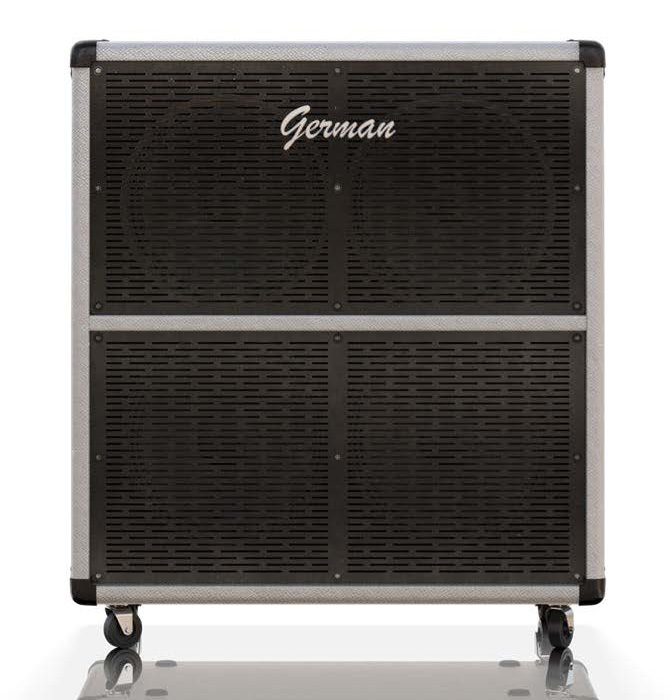
This metal-grill fronted Teutonic knight of a cab can definitely hold its own when it comes to high-gain riffage. Primarily about sweet mids, but also conjures up a rich low-end response.
Speaker: Celestion G12M-25 Greenback
Higain Vintage 4x12
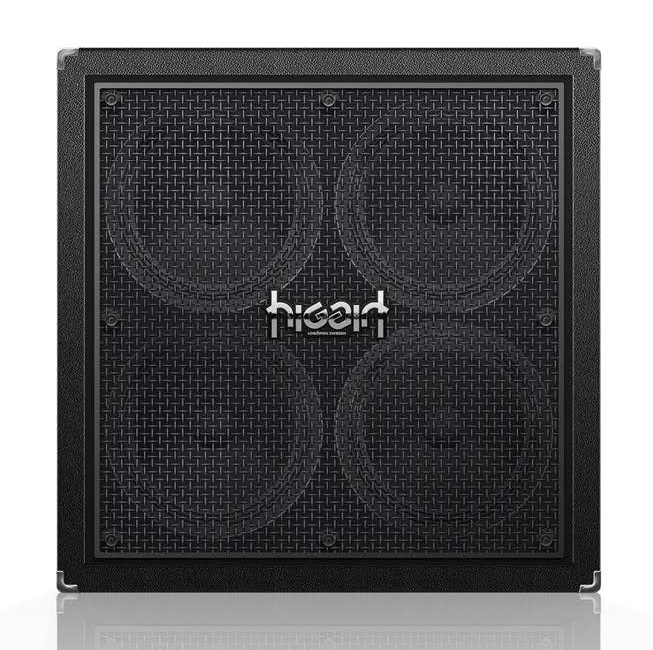
A cabinet that oozes of German precision and is, to some extent, "unforgiving" due to its uncompromising ability to articulate sounds. Then again, this is also the reward of using this cabinet. Notes cut through and riffs never feel muddled, especially if you are a high-gain player.
Speakers: Celestion Vintage 30
Marshall JCM800 Lead 4x12

It is impossible to exaggerate the importance and impact of the Marshall 1960 Lead cabinet. Apart from being the #1 cab choice of the NWOBHM movement, it's slightly scooped mids and well-rounded lows will do an excellent job with whatever you choose to throw at it.
Speaker: Celestion G12T-75
Marshall 8412 4x12
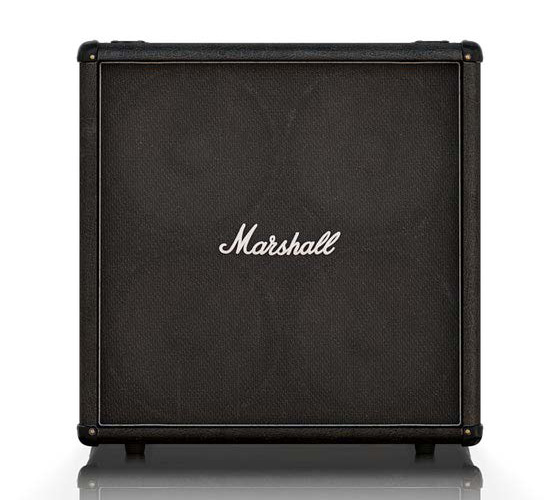
The 140W 4x12" Marshall Valvestate cabinet might not be on everyone's radar, but it truly is a "sleeper" for most needs. Definitely delivers a chunky thump to anyone looking for a cabinet with great palm-mute response.
Speaker: Celestion G12L-35
British Closed 2x12
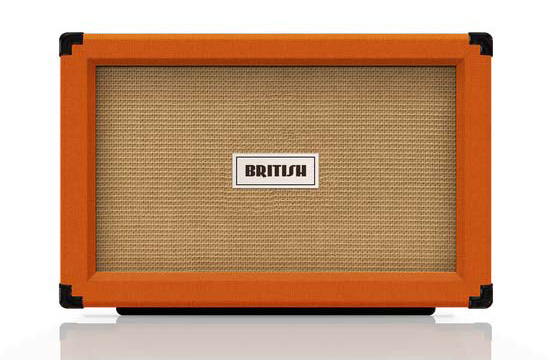
Looking for tightness that is second to none? How about also carrying a very percussive mid-punch? If you want riffs and notes to really stand out, regardless of volume and/or playstyle, then this is the cabinet for you. Almost impossible to make sound bad.
Speaker: Celestion Vintage 30
MUG 4x12
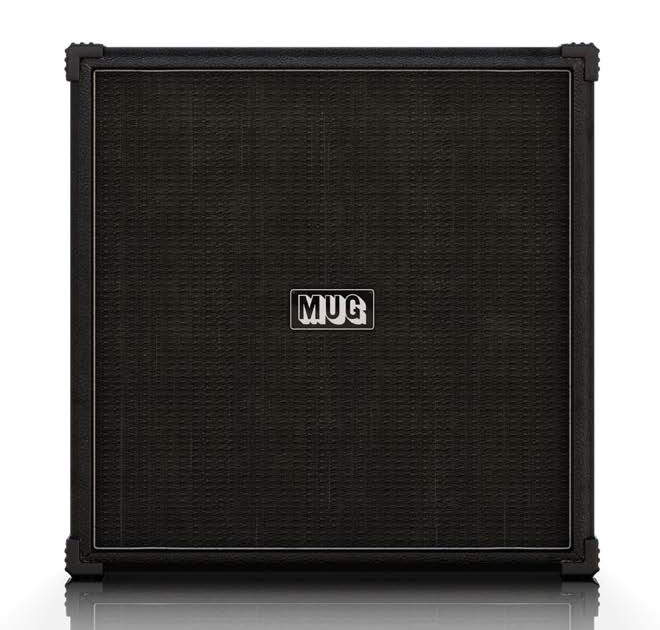
MUG is an abbreviation of "Musik Utan Gränser", a legendary music store in Gothenburg, Sweden.
In the early 00's MUG tried their hand at a series of 4x12" cabinet under their own name. Today you have to look long and hard before you see one for sale.
MUG cabs had many different configurations (speakers, wood, frame thickness etc.) thus giving many of them a unique voice. This particular frontloaded MUG cabinet has a dark, smooth personality. Treat it right and you might end up with a winner.
Speaker: Celestion G12S-50
LoadIR
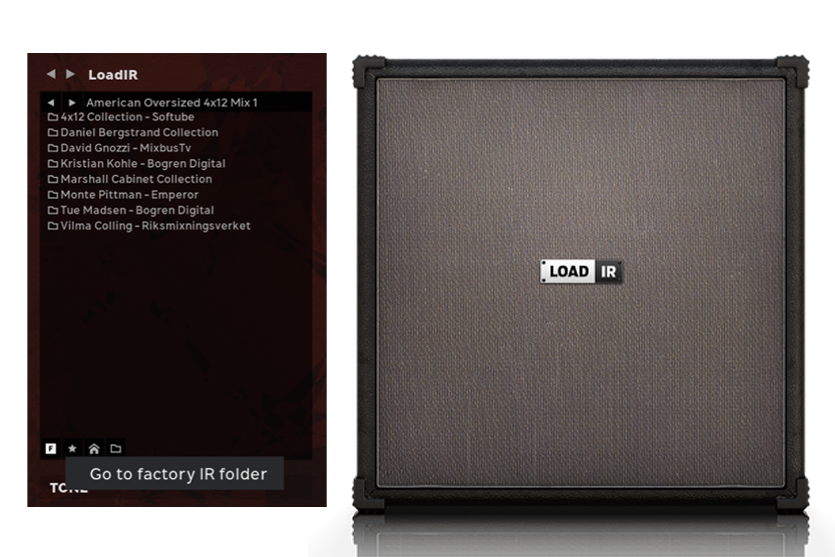
Load your own impulse responses (IRs) to create a totally customized signal chain. Any .wav file of standard sample rates and regardless of length can be uploaded into LoadIR, however only max 1 second, counting from the start, will be used.
Click the F (for Factory presets)-button to access the included Producer IR Packs and much more.
Included in the cabinet section is the IR loader module LoadIR. Locate it by clicking “Show All Cabs” in the cabinet section and looking last (far right) in the cabinet Gear menu.
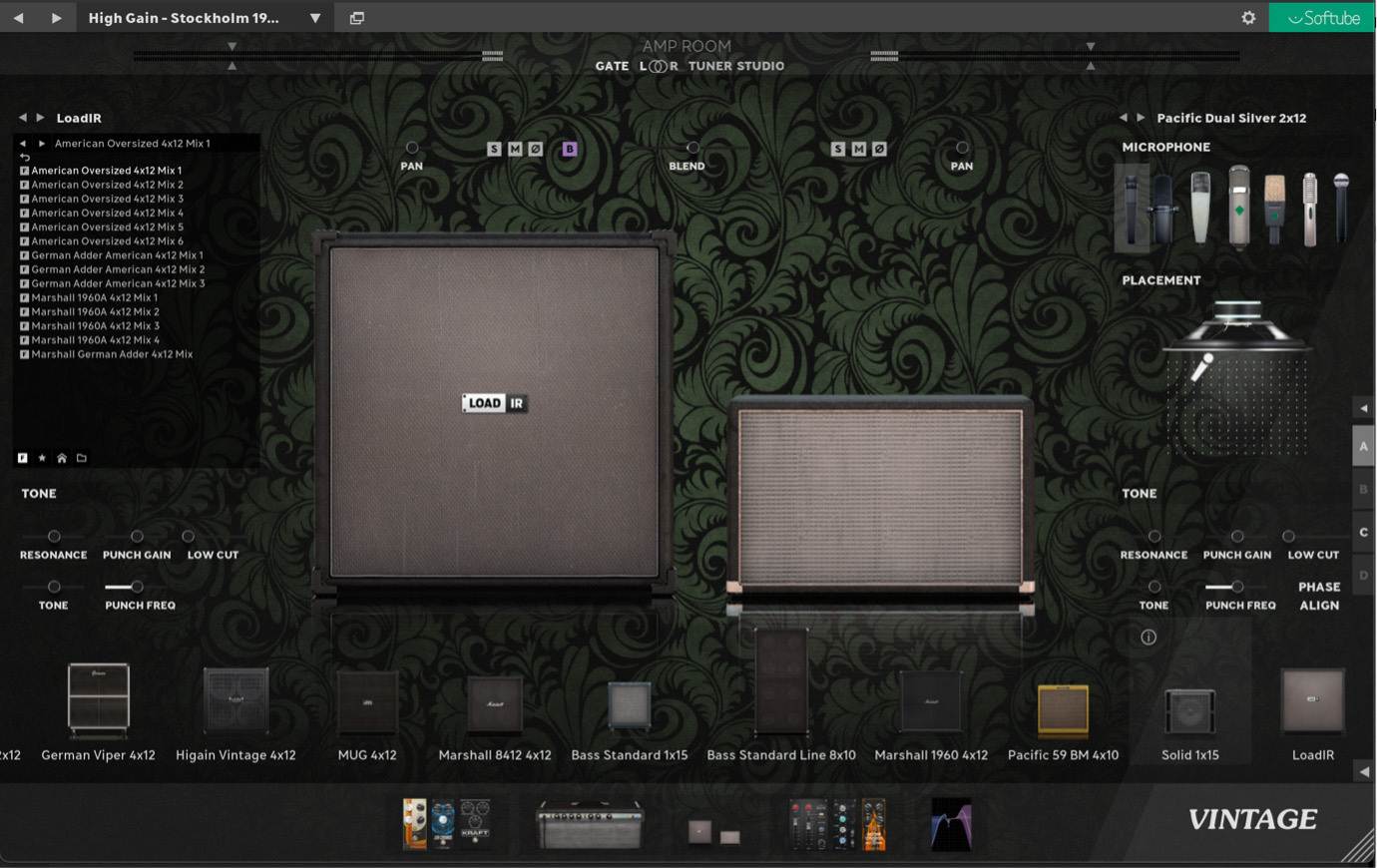
Microphone selection and positioning is not available for IRs, but the Tone controls are.
Step through the IRs by either the arrows next to the IR file name or by clicking directly in the drop-down list.
Clicking on the F icon at the bottom of the IR selection window will take you to the factory included IR folders. Click on a folder to access it. Click on the curved arrow to take you one step higher in folder hierarchy.

Every IR has two options to it.
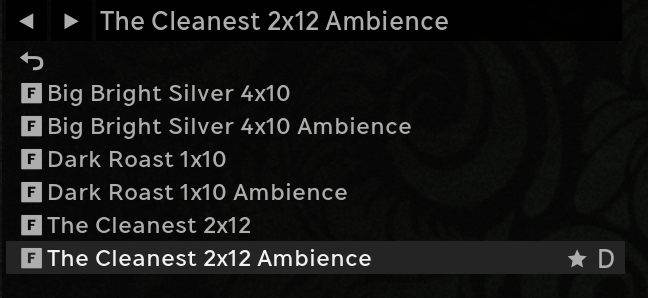
Clicking the star will add the IR to your favorites folder. Clicking the D will set the IR as the default IR when using the LoadIR module.
Access your favorites folder by clicking the star icon at the bottom of the IR selector window. Remove an IR from your favorites folder by clicking the IR’s star when in the favorites folder.

If you have your own IR library, access the OS browser by clicking the folder icon at the bottom of the IR selector window. Navigate through your HD and select an IR. The selected IR, along with all/any other IRs in the folder, will appear in the IR selector window. Step through them as you would with the factory IRs.

When a User IR is loaded and the OS folder is shown in the LoadIR display, alt/option + click the home icon to set the current OS folder as your home folder.
In the Settings menu (cog wheel icon, top right corner) there are two options that concern LoadIR. Normalizing non-factory IRs is to safeguard against third party IRs that might be harmfully loud. Automatically phase aligning third party IRs with Amp Room cabinets and IRs is for safeguarding against getting unwanted artifacts, such as phasing. Both can be unchecked but should be done so with care and at own risk.

An inserted IR will be saved along with the DAW project. Meaning, if the project is moved to another computer that does not have the selected IR locally LoadIR will still contain this IR and the signal chain will play as intended.
Saving a preset where LoadIR is used to Preset Collection will also save the IR to the preset.
The IR loader LoadIR supports .wav files in 16/24/32 bit (so basically any bit depth and in all sample rates (44.1, 48, 96, 176.4 and 192 kHz) up to 1 second for both mono and stereo IRs. If you choose to load a longer .wav file just for the heck of it, LoadIR will automatically introduce a fade after 0.8 seconds to comply with the 1 second length limitation.
Kleen 22 clean boost
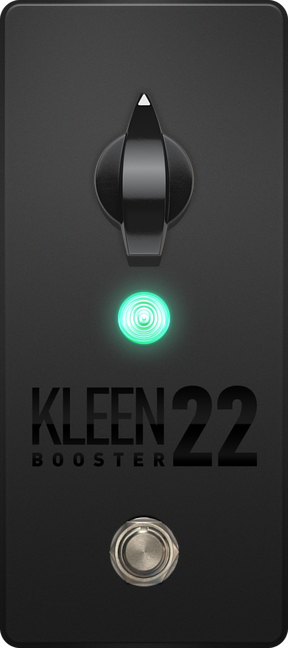
Want to make a roaring monster out of any old amp? In that case, the Kleen 22 is the pedal for you! It will add up +22dB of clean boost to the signal in addition to cutting some of the low frequencies to the keep the sound nice and tight.
Softube Tube overdrive
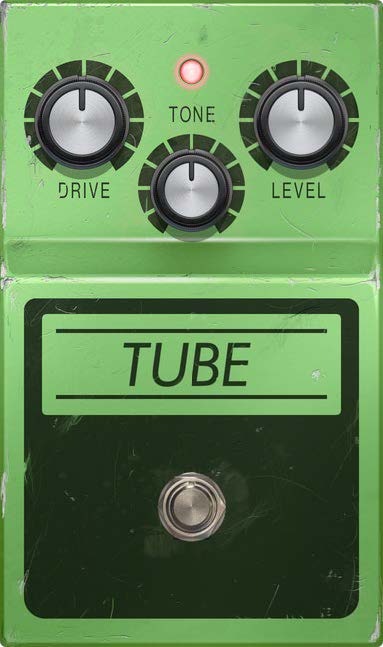
Distortion probably doesn’t get any more classic than this unit. You could call the Tube pedal the mother of all distorted sounds. This overdrive pedal, with its tube-like characteristics, can be useful when your amplifier isn’t heavy enough. The mid boost provided here is typically popular among rock and blues guitarists. The Softube Tube overdrive pedal can even be used to mimic the sound of a vintage tube amplifier all by itself.
Operation is simple. Adjust the Drive knob for the right amount of dirt, use the Tone knob to set the treble content and let Level balance the overall output volume of the pedal.
Softube EQnäs EQ
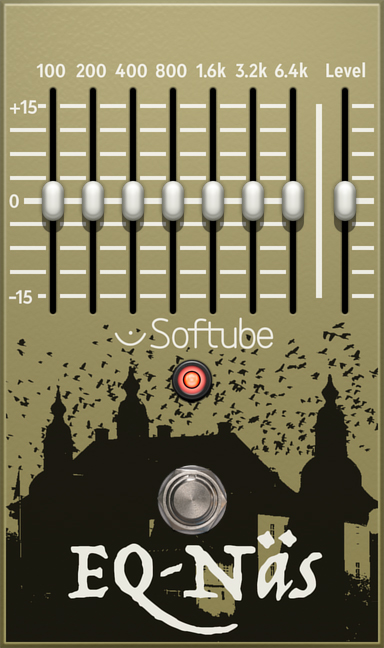
A seven band EQ can be a lifesaver in so many situations. You may have created a sound in Amp Room that is almost there. It just needs a little less low mids or more sparkle. EQnäs can save your day and make the difference between a good sound and a great one.
Placing an equalizer in front of a tube amp can help the amplifier come alive, make it scream and behave more aggressively. Depending on what frequencies you boost or cut, your tube amp will react, so it’s definitely worth pushing all the EQ sliders and/or Level slider up or down to reach your desired result.
An EQ can also provide an effective method to make an instrument cut through a dense mix, or to whip up a telephone filter. You can even use the filter sliders to create a makeshift comb filter (push every second slider up and every second slider down on the left side and make an inverted EQ setting on the other side).
The seven sliders affect frequencies between 100 and 6,400 Hertz with a ± 15 dB range. The Level slider on the right can be used to compensate for any undesired volume change caused by the frequency sliders. It also has a ± 15 dB range.
Ekenäs Castle is a 17th century Baroque- style castle located outside of Linköping.
Softube ODR overdrive
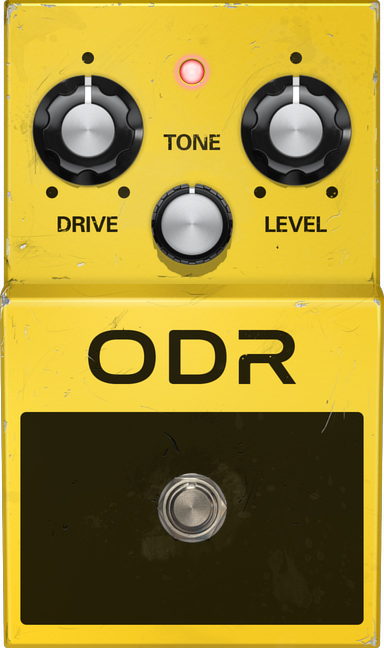
The classic dual-stage overdrive circuit modeled in this pedal offers loads of sustain and compression, while preserving the dynamics of the input sound in a great way. If non-muffled, dynamic tones reminiscent of overdriven tube amps is what you want, the ODR overdrive is your choice.
You could try out different settings on this pedal. Drive can be set very low as a rather clean booster or higher for increased grit and compression, perfect for crunch and lead sounds. The Tone knob is vital for taming the overdrive effect and adjusting the overall character. Level takes care of the output volume.
Softube Rökstenen distortion
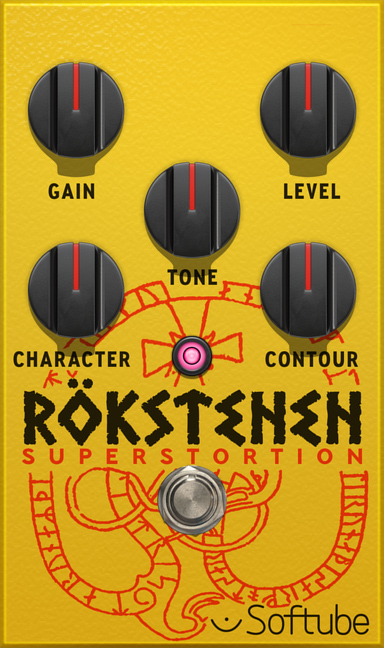
This pedal can produce a wide variety of distorted sounds. If you focus on the Character knob, you’ll notice how Rökstenen Superstortion changes ... well ... character quite drastically.
The center position of the knob represents a standard distortion sound. This can serve as a good starting point for further experimentation. Set the Gain and Level controls to get a general suitable sound. Then turn Character to the left, and you’ll notice how the sound gradually changes to a muddier, brown type of overdrive. Going from 12 o’clock to the right will change the effect to a tighter distortion.
We could even recommend that you try using Superstortion without an amp or even a cab. You may be surprised how well it functions on its own.
Gain sets the overall amount of grit while the Level knob adjusts the total output volume. The Tone knob acts like a tilt control; center is flat, a setting to the left boosts bass and reduces treble, while turning it to the right will give you a brighter, thinner sound. Contour determines the overall timbre, going from a traditional loudness curve (boosted bass and treble) to flat (12 o’clock) to mid boost.
Rökstenen is a Viking age runestone from the 9th century located outside of Linköping. It has the longest known runic inscription in a stone and is also the first piece of Swedish literature.
Integrated Preamplifier preamp
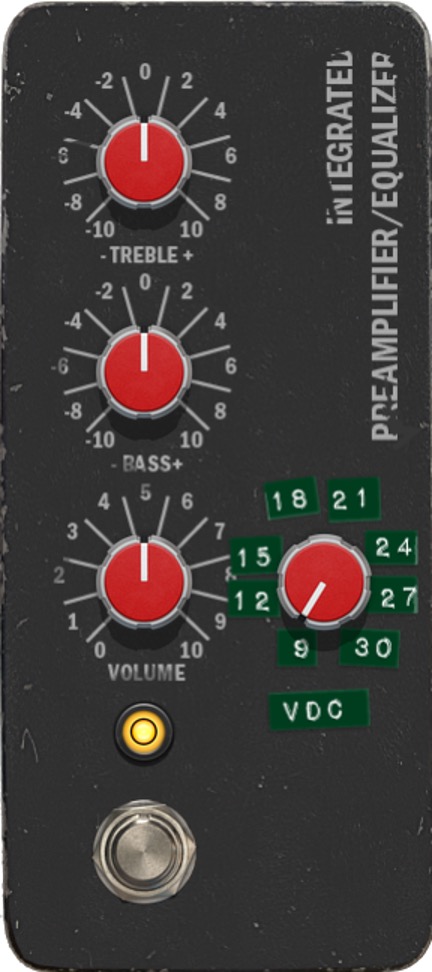
Inspired by the highly sought-after preamplifier and EQ pedal that works magic on clean and crunchy tones as well aggressive high gain ones. This little gem will powerfully shape your guitar tone without losing any articulation.
The physical pedal works with voltage ranging from 9 to 32 volts. There are many opinions on with which voltage it sounds and behaves the best. We have added a stepped voltage parameter to our module for easy experimentation where you can be the judge.
Softube Doom Chvrch reverb

The Doom Chvrch reverb is a marriage between vintage and modern. Some parts, such as the modulation and diffusion, are inspired by the classic EMT 250 reverb, while the reverb tank itself comes from the huge hall we built for the Parallels® instrument. It was designed to allow you to go from a short “boxy” room sound, to epic and almost infinite perturbations that evolve over time into something completely different. It was never intended to sound realistic; it was designed to sound good.
Doom Chvrch is a stereo reverb that will give you a stereo output, even if the input is a mono signal. You can therefore use it in subtle amounts to give some depth to your track. The Time knob provides almost infinite reverberation. Mix adjusts the dry/wet balance and the Bass and Treble controls let you adjust the overall tone of the reverb effect.
“Doom Chvrch” is a local wordplay on the Domkyrka (Cathedral) of Linköping. Founded in the 13th century, it is a prominent part of the Linköping skyline.
Softube Wildboar delay
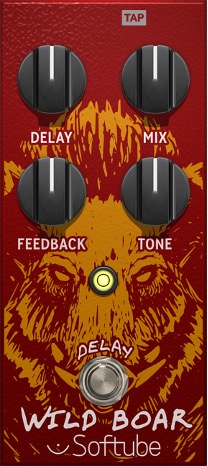
Delay or echo is one of the most desirable and necessary effects for many musicians, not only synth players, singers, and guitarists. When introduced in the fifties, tape effect units provided a method of adding space around singers and made instruments sound more exciting. Later it became a way of adding rhythmic effects in musical arrangements.
Delay sets a delay time from 20 to 1,000 ms. The Mix knob goes from completely dry to 50/50 (at 12 o’clock) to delay only. Feedback gives you anything from a single delay to almost infinity, and the repeats continue even after you turn the pedal off. If you want to quickly cut off the echoes, just turn down the Feedback knob. Tone does not affect the delay signal at all when set to 12 o’clock. Move it to the left to reduce treble and to the right to reduce bass.
At the module top bar there is also a Tap tempo function! Tap away to get the delay time you are looking for!
Sweden is largely covered by forest and, due to the country’s relatively low population density, rich in wildlife. The area around Linköping is particularly rife with wild boar.
Kraft overdrive

An overdrive/fuzz/distortion pedal masterpiece. Probably featured on more of your favorite recordings than you realize, and that is almost regardless of music genre.
The Kraft pedal transitions easily between warm, tempered overdrive to heaving chunks of heavy gain all around. Thanks to its renowned tone filter the output signal never lacks “muscle” or body and the pedal works just as well for bass as it does for guitar.
Whatever you are looking for in the gain, fuzz and/or distortion department, this is a good place to start your search at.
Softube Trollegater noise gate

Stacking up a load of pedals, especially those that add some kind of distortion, may result in a huge amount of noise building up. A noise gate can come in handy if noise becomes a problem.
One method is to put the gate last in the chain. That way, you will get rid of all unwanted hiss and rumble from your rig. However, if you use delay and reverb effects after overdrive and distortion pedals, the noise gate may cut off the tails of those effects. You could then try placing the gate before echo and reverb.
The Trollegater will always do its best to assist you in removing noise while preserving the music, but you must give it a little help. Start by turning the Threshold knob all the way to the left. With your instrument connected and all effects on but no music playing, listen closely to the noise. Increase the Threshold knob until the noise disappears. This is your correct setting!
Trollegater (transl.: Troll + gata = troll street) is a nature reserve outside Linköping with one of Sweden's largest natural cave systems.
American Class A 25 compressor
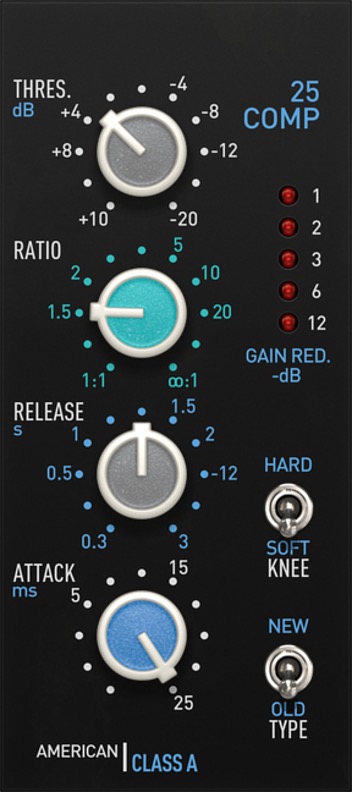
This unit is based on Softube’s take on the greatest classics of American mixing console hardware – a compressor with a famously punchy sound.
Apart from the standard compressor controls, American Class A also features a switch which allows you to choose between a feed forward or a feedback style of compressor. The feed forward (Type = New) is controlled and predictable, while the classic feedback mode (Type = Old) is more punchy.
A Hard Knee has a sharper transition between compressing and non-compressing states. A Soft Knee offers a more gradual transition, where the ratio gradually increases around the threshold. For most applications, Soft Knee is where you want to set it.
The Attack can be set between 1 and 25 milliseconds and the Release from 0.3 to 3 seconds. The Ratio knob sets the ratio which, in general, is often less than what the panel says. Threshold is adjustable from +10 to –20 dBu.
The Gain Reduction meter shows you how much the compressor squishes the sound.
You can either place it as a pedal style compressor in front of an amp, or you can use it as a mixing tool at the end of the signal chain. When using it as a mixing tool, we recommend that you listen to your guitars together with the rest of the mix. You will come a long way with just a touch of compression.
American Class A 55 EQ
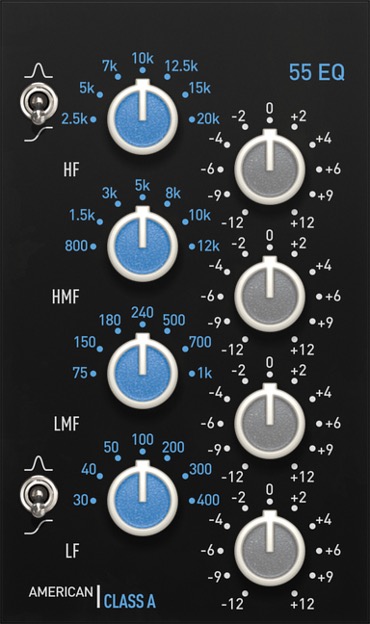
This EQ is based on a classic console equalizer that made it into a four-band 1U mastering equalizer, a Softube Console 1 strip, and now finally turns up inside Amp Room! This EQ is rock music. The weight of the mids are legendary and the punch of the low end can be heard on countless albums.
The four EQ bands each have 7 center frequencies. The Gain knobs are divided into 11 steps, ranging from –12 to +12 dB.
Both the high and the low filter can be switched between Shelving or Bell filters.
You can either use it as a pedal style EQ in front of an amp, or as a mixing tool to sculpt the output of Amp Room. Anything goes!
The Gain Reduction meter shows you how much the compressor squishes the sound.
Room Ambience RoomIR
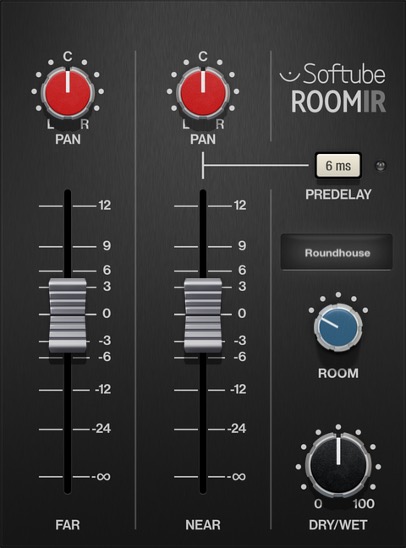
If you connect an instrument to your sound card and run the signal through Amp Room while using headphones, you will hear a completely dry signal.
With this effect somewhere near the end of your signal chain, you can add some natural room ambience.
Five room impulse responses are available. All of them have Near and Far faders, plus you can choose to delay the Near response with a pre-set predelay time to achieve a great slap-back effect. The two Pan knobs lets you spread out the room impulses in the stereo field.
Room info:
Note: The output of this effect is in stereo. To hear the full stereo sound, you may have to switch the track in your DAW to stereo.
Patrik Jensen – Product Owner
Johan Toverland – Project Management
Stefan Aronsson – Product Marketing
Kim Larsson, Mattias Flygare, Fredrik Jansson, Anton Eriksson and Niklas Odelhom – DSP modeling
Pelle Serander, Patrik Holmström and Arvid Johnsson – Framework programming
Björn Rödseth – DSP backend programming
Niklas Odelholm – General graphic design
Ulf Ekelöf, Thomas Merkle, Nis Wegmann and Manuel Colom – Graphic design
Stefan Aronsson and Patrik Jensen – Presets
Emanuel Enbäre and Niels Nielsen– Quality assurance
Thank you to: Daniel Bergstrand @ SDFX, Kristian Kohle @ Kohlekeller Studio, Thomas Plec Johansson @ The Panic Room, David Castillo @ Studio Gröndal, Tue Madsen @ Antfarm Studio, Vilma Colling @ Riksmixningsverket, Jacek @ Bogren Digital, David Gnozzi @ MixbusTv, Calle Thomer @ Vildhjarta, Buster Odeholm @ Odeholm Audio, Monte Pittman and Mikael Almgren.